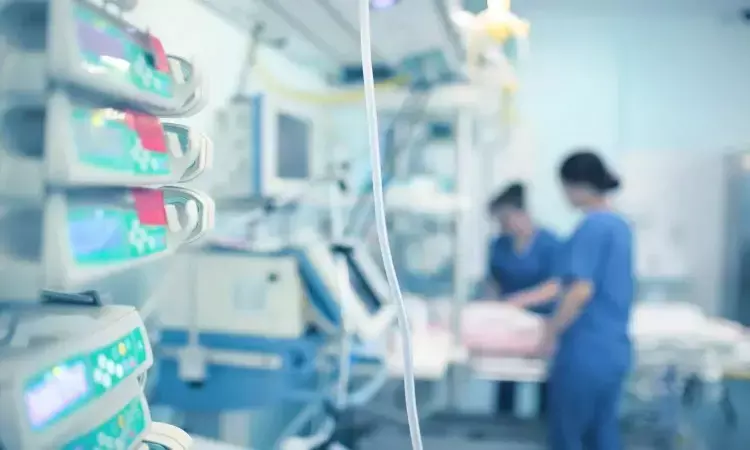- Home
- Medical news & Guidelines
- Anesthesiology
- Cardiology and CTVS
- Critical Care
- Dentistry
- Dermatology
- Diabetes and Endocrinology
- ENT
- Gastroenterology
- Medicine
- Nephrology
- Neurology
- Obstretics-Gynaecology
- Oncology
- Ophthalmology
- Orthopaedics
- Pediatrics-Neonatology
- Psychiatry
- Pulmonology
- Radiology
- Surgery
- Urology
- Laboratory Medicine
- Diet
- Nursing
- Paramedical
- Physiotherapy
- Health news
- Fact Check
- Bone Health Fact Check
- Brain Health Fact Check
- Cancer Related Fact Check
- Child Care Fact Check
- Dental and oral health fact check
- Diabetes and metabolic health fact check
- Diet and Nutrition Fact Check
- Eye and ENT Care Fact Check
- Fitness fact check
- Gut health fact check
- Heart health fact check
- Kidney health fact check
- Medical education fact check
- Men's health fact check
- Respiratory fact check
- Skin and hair care fact check
- Vaccine and Immunization fact check
- Women's health fact check
- AYUSH
- State News
- Andaman and Nicobar Islands
- Andhra Pradesh
- Arunachal Pradesh
- Assam
- Bihar
- Chandigarh
- Chattisgarh
- Dadra and Nagar Haveli
- Daman and Diu
- Delhi
- Goa
- Gujarat
- Haryana
- Himachal Pradesh
- Jammu & Kashmir
- Jharkhand
- Karnataka
- Kerala
- Ladakh
- Lakshadweep
- Madhya Pradesh
- Maharashtra
- Manipur
- Meghalaya
- Mizoram
- Nagaland
- Odisha
- Puducherry
- Punjab
- Rajasthan
- Sikkim
- Tamil Nadu
- Telangana
- Tripura
- Uttar Pradesh
- Uttrakhand
- West Bengal
- Medical Education
- Industry
Opioids or NSAIDs- Which are safer and more effective for treating pain after surgery in youth

USA: A new study compared two treatment regimens-one that uses a regimen of non-opioid medication and another that adds a low-dose opioid-to determine the safest and most effective way to treat pain in adolescents and young adults recovering from common outpatient surgeries. The study was led by led by investigators at the University of Michigan and Children’s Hospital Los Angeles.
Thousands of adolescents and young adults have outpatient surgery every day and are sent home with pain medication. Although the need for medication is clear, the best way to treat the pain is not.
In the past, opioids were commonly prescribed to treat pain following surgery. However, the opioid epidemic has caused families and physicians to be reluctant about exposing young people to these medications due to side effects and the possibility of abuse. This has led many healthcare providers to use nonsteroidal anti-inflammatory drugs (NSAIDs) plus acetaminophen without prescribing opioids. But the question remains: Do these medications adequately relieve pain?
“This study will provide the information that I need to be able to counsel families,” says Lorraine Kelley-Quon, MD, a pediatric surgeon at Children’s Hospital Los Angeles and co-principal investigator of the study. “We need to define the right balance of medications to effectively minimize pain while not introducing unwanted side effects. This study will provide that missing information.”
The CARES for Kids study (Comparing Analgesic Regimen Effectiveness and Safety After Surgery for Kids) will be the first prospective, randomized, controlled trial-considered the gold standard-comparing opioid and non-opioid pain medication following common surgical procedures in adolescents and young adults. The Patient-Centered Outcomes Research Institute
“Appropriate pain relief impacts many people-the patient, their family, the surgeon and the patient’s physician,” says Mark Bicket, MD, PhD, an anesthesiologist at the University of Michigan and principal investigator of the study. “All these people come from different perspectives but have the same objective-the safety and comfort of the patient. This study incorporates these varied viewpoints by having an advisory board involved from the earliest days of study design until the study conclusion.” The advisory board includes patients, caregivers, pediatric medical and surgical associations, payers and community organizations.
The study will enroll 900 adolescents and young adults between 12 to 20 years of age who are undergoing tonsil removal, gallbladder removal or arthroscopic knee surgery. Participating patients will be randomly assigned on the day of surgery to receive either an NSAID and acetaminophen alone or a regimen that also includes a low-dose opioid. Subsequently they will be surveyed on a mobile device or by a phone call up to one year after surgery to answer questions about short- and long-term pain, insomnia, medication side effects like constipation and prolonged opioid use or misuse.
Patients will be enrolled at these four study sites:
• Children’s Hospital Los Angeles (CA)
• Nationwide Children’s Hospital (OH)
• Stanford Medicine Children’s Health (CA)
• Michigan Medicine (MI)
“We are grateful to PCORI for taking a leadership role in funding multiple trials to develop research-based evidence about the effectiveness of using pain medication in adults,” says Dr. Kelley-Quon. “But since it isn’t possible to extrapolate information gained from an adult study to a pediatric population, this is a truly unique study-done in adolescents and young adults-and will impact millions of families each year.”
Dr Kamal Kant Kohli-MBBS, DTCD- a chest specialist with more than 30 years of practice and a flair for writing clinical articles, Dr Kamal Kant Kohli joined Medical Dialogues as a Chief Editor of Medical News. Besides writing articles, as an editor, he proofreads and verifies all the medical content published on Medical Dialogues including those coming from journals, studies,medical conferences,guidelines etc. Email: drkohli@medicaldialogues.in. Contact no. 011-43720751


